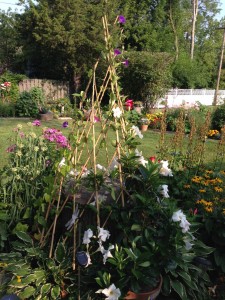For over twenty five years, one of my Spring/Summer hobbies has been the cultivation of Morning Glory flowers. In the process of tending to their needs and those of other varieties of climbing plants, I learned that what allows these plants to grow into their full potential has amazing similarities to what, I believe, people and especially children need for their potential to fully blossom. In this article, I will share how this hobby came about and the principles it taught me about training.
My wife and I have been married for over twenty five years. We first lived in a condominium that had a large terrace over our two-car garage, which was an ideal spot for growing flowers in the warm months. One of the flower varieties she introduced me to was the Morning Glory. You start it from seed and it quickly shoots out of the ground, grows a couple of leaves and starts to shoot a creeping stem. Imbedded in the DNA of this vine is a compulsion for wrapping itself around anything that will allow it to run away, reach out for the light and blossom into countless flowers, every morning!
However, left up to its own devices, the vine will likely wrap itself around its own parts, choke itself in the process or greatly sub-achieve its true potential by grabbing to things that lead nowhere. Having intuitively understood the plant’s desire to run away and gain strength from the light and warmth of the sun, I started building an architecture of strings, starting at the base of the large wooden planters, shooting upward and then sideways to reach the metal railings around the terrace. Once they reached the railings, the vines had ample opportunity to keep on running. At their peak a total of two dozen vines were producing well over two hundred fifty flowers every morning, to our delight and the delight of neighbors!
Then what? What are these principles that I learned? Besides the obvious like good soil, water/sun (a lot of it in the case of morning glories), here we go with the learning:
1- A structure is needed:
Someone has to think through a (teaching/training) structure that respects the constraints of the environment and creates optimum opportunities for growth.
2- Structure by itself is not sufficient:
Structure itself cannot be expected to deliver optimum results. There must be someone to train the young stems to use the structure laid before them. The younger the stem, the more likely it is not to recognize the structure and lose its way. Consistent energy must be invested by the teacher/trainer to help guide the stems along the path.
3- The trainer must stay vigilant as growth accelerates:
As the vine grows and develops its leaves, it gains energy and builds momentum in its growth. Vigilance and continued training by the coach are needed at this stage because of the faster growth.
4- The coach keeps a watchful eye over the maturing plant:
As the vine matures and starts to blossom, the trainer still keeps a watchful eye on the slowing growth process and still makes minor tweaks.
5- The coach must recognize what the plant comes already equipped with:
Like people, climbing plants come equipped with different climbing gear (so to speak). In the plant realm, they are called twining, suction cups, tendrils, curling strings, thorns. For people, they are talents and abilities. A good coach/teacher/trainer knows how to recognize and work with those assets.
I have learned much from tending to my climbing plants. Today our backyard is home to nine different species of climbing plants, including two varieties of Passion Flowers, three Trumpet Vines, Climbing Hydrangea, a rambling rose bush, three Clematis, a Bean Runner, Honeysuckle, Mandevilla and Morning Glory, indeed! I am thankful to my plants for helping me learn some finer points about training and realize that I find coaching and training most rewarding and enjoyable.









 Follow
Follow
